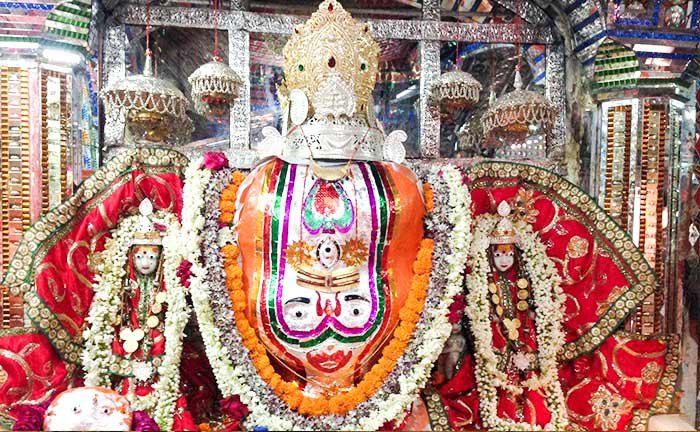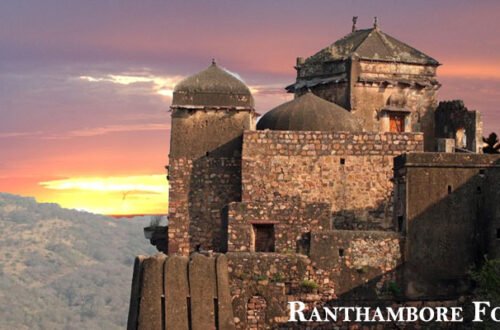Nestled within the rugged terrains of Rajasthan’s Sawai Madhopur district, the Ranthambore National Park is not only home to majestic tigers and wildlife but also to one of the region’s most spiritually significant landmarks—the Trinetra Ganesh Temple Ranthambore. Perched within the ancient Ranthambore Fort, this temple stands as a timeless symbol of devotion, faith, and enduring cultural heritage, drawing lakhs of pilgrims and tourists year after year.
The temple is believed to be one of the oldest temples dedicated to Lord Ganesha in India and is unique in its iconography. What sets it apart is the rare representation of Lord Ganesha with his complete family—Riddhi, Siddhi, and his two sons, Shubh and Labh. For devotees, visiting this temple is not just a religious activity but an immersive cultural experience that connects them with centuries of regional history, myth, and tradition.
A Temple Carved in Time and Stone
The Trinetra Ganesh Temple is situated within the UNESCO World Heritage-listed Ranthambore Fort, which dates back to the 10th century. According to popular folklore, the temple was built after King Hamir Dev Chauhan dreamt of Lord Ganesha and discovered an idol of the deity embedded in the fort walls. Since then, the temple has been revered as a powerful center of divine energy.
It is the only temple in India where Lord Ganesha is worshipped along with his full family. This cultural uniqueness enhances the temple’s spiritual significance and has made it a vital stop for devotees, especially during major Hindu festivals such as Ganesh Chaturthi. The steady flow of offerings, particularly wedding invitations mailed directly to the temple, is a testament to the enduring faith and trust devotees place in the deity.
Historical Relevance and Religious Practices
The temple has witnessed centuries of royal patronage, invasions, and cultural exchanges, yet it continues to thrive as a bastion of Hindu faith. Ranthambore’s strategic location made it a site of numerous battles, and the Ganesh temple served as a source of strength and hope for its rulers and people.
Unlike many other temples, the Trinetra Ganesh Temple is open throughout the year and welcomes thousands of visitors each month. The atmosphere is a blend of quiet reverence and the occasional sounds of bhajans echoing across the fort. The priestly lineage that maintains the temple has done so for generations, reinforcing the temple’s authenticity and cultural authority.
Every day, hundreds of letters and wedding cards arrive at the temple, symbolizing people’s unwavering belief that Lord Ganesha must bless every new beginning. This ancient tradition is still observed with sincerity, indicating the temple’s trustworthiness as a spiritual guide in people’s lives.
The Pilgrimage Experience
The journey to the temple is a pilgrimage in itself. Located at the top of Ranthambore Fort, visitors must climb several stone steps, passing through historic gates, ramparts, and scenic overlooks that tell stories of bygone eras. This effort only deepens the spiritual satisfaction for devotees reaching the temple at the summit.
On the way up, one often hears echoes of traditional hymns, sees monkeys playing along the pathway, and encounters locals offering guidance or sharing stories of the fort and temple. For those planning a spiritual escape to this region, finding a serene place to stay becomes essential. If you’re looking for the Best resort in Ranthambore to complete your culturally enriching trip, you’ll discover that some local resorts are designed to harmonize with the area’s heritage and natural beauty.
Cultural Integration with Local Life
The temple’s cultural importance goes beyond religious observance. It has become an integral part of local identity in Ranthambore. Markets around the fort sell miniature idols, religious threads, sweets, and other offerings tied to Ganesh worship. Festivals such as Ganesh Mela attract thousands of visitors, with folk performances, community feasts, and traditional craft displays reinforcing the bond between faith and culture.
Local families often narrate stories passed down through generations about miraculous events associated with the temple. These oral traditions enrich the temple’s cultural footprint, giving depth to its historical and spiritual reputation. Unlike modern temples built in urban settings, this one embodies a holistic cultural ecosystem where architecture, environment, and community coalesce.
Stay Experiences Near the Temple
Visiting such a spiritually important site warrants an equally immersive stay. Many travelers prefer a peaceful, nature-integrated experience while visiting the area. For a truly unique and traditional stay, consider a Tent stay in Ranthambore that captures the essence of Rajasthani heritage. These accommodations often blend modern comfort with rustic charm, allowing guests to feel connected to the landscape and culture of Ranthambore while being just a short drive away from the fort and temple.
The gentle crackle of a campfire, traditional Rajasthani folk music, and the silence of the surrounding jungle all contribute to a soulful travel experience. These resorts often collaborate with local guides and historians who can provide deeper insights into the cultural and religious significance of landmarks like the Trinetra Ganesh Temple.
Preservation and Modern Relevance
Preserving a cultural monument like this temple involves more than physical restoration. It includes keeping the traditions alive, maintaining historical records, and involving the younger generation in temple activities. The temple’s trust and local authorities work actively to protect the site from environmental damage and maintain its sanctity.
In today’s era of fast-paced digital lives, the temple serves as a grounding point—a place where time seems to slow down, and one reconnects with deeper values. Its presence in a wildlife sanctuary also subtly reminds visitors of the harmony that once existed between humans, nature, and spirituality.
Whether you’re a pilgrim, history enthusiast, or cultural traveler, the Trinetra Ganesh Temple in Ranthambore offers more than a visit—it offers a transformative journey.





